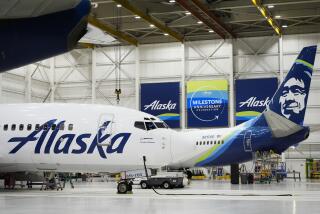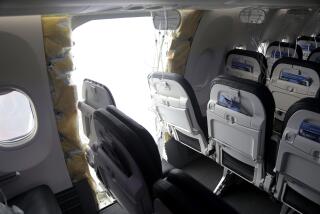FAA steps up investigation of Boeing 787 Dreamliner
The investigation into battery problems on the much-heralded Boeing 787 Dreamliner expanded to the plane’s Japanese battery manufacturer and the Arizona makers of other electronic components.
Federal Aviation Administration officials Monday joined authorities in Japan who are looking into the manufacturing process at the Kyoto maker of the lithium-ion battery that caught fire on two recent Dreamliner flights, prompting the FAA last week to ground the plane.
Federal regulators have already eliminated one potential cause of the battery problems: The National Transportation Safety Board concluded over the weekend that a battery that caught fire on a Dreamliner in Boston was not overcharged. The NTSB is an independent federal agency that investigates civil aviation accidents.
The Dreamliner, Boeing’s most advanced commercial plane, has been plagued by mechanical problems, most recently the battery that caught fire on a Japan Airlines 787 in Boston on Jan. 7 and one that burned Jan. 16 on an All Nippon Airways 787 and prompted an emergency landing in southwestern Japan.
FULL COVERAGE: Boeing’s troubled Dreamliner
All Nippon and Japan Airlines, which combined operate more than half of all Dreamliners, have canceled flights on the plane through Jan. 28.
The outcome of the investigation could determine whether Boeing’s $200-milion planes can get back in the air soon or must undergo a major redesign of their auxiliary power system.
Although older planes rely on much heavier hydraulic systems, the Dreamliner uses lithium-ion batteries and electronic motors, making the 787 lighter and 20% more fuel efficient than other wide-body planes.
The investigation into the battery problems continues as NTSB investigators head to Phoenix on Tuesday to talk to officials at UTC Aerospace Systems, the company that built the plane’s auxiliary power controller.
They also plan to visit Securaplane Technologies, the Tucson aerospace component maker that builds the Dreamliner’s battery charger.
Representatives for UTC and Securaplane said the companies will cooperate with the investigation.
“UTC Aerospace Systems is fully supporting the Boeing and the Federal Aviation Administration’s joint review of 787 systems,” said Dan Coulom, a spokesman for the company, who declined to comment further.
On Monday, Japan’s transport minister sent investigators to GS Yuasa Corp., the manufacturer of the lithium-ion batteries. They returned Tuesday to continue the inquiry. An FAA investigator and a technical advisor are assisting the Japanese team in the investigation.
“We’re checking whether the batteries for the 787 were made as designed and went through a complete quality-control process,” said Tatsuyuki Shimazu, an engineer at the Civil Aviation Bureau in Japan.
The NTSB said Sunday that an examination of flight recorder data from the Japan Airlines 787 in Boston shows that the auxiliary power battery did not exceed its designed 32 volts. Photos released by the NTSB show a battery with a charred black interior and front panel.
Meanwhile, Boeing has not delayed production of the nearly 800 Dreamliner planes it has committed to deliver to dozens of airlines around the world.
The Boeing assembly plant in Everett, Wash., continues to build the planes at a rate of five a month but won’t deliver any until the FAA lifts its order grounding the Dreamliner, Boeing spokesman Doug Alder Jr. said.
Boeing officials declined to discuss what, if any, compensation the Chicago plane manufacturer must pay the airlines for any setback in deliveries.
But aerospace analysts say that if the battery problems lead to lengthy delays, the carriers are likely to ask Boeing for compensation or a discount on the delivery of future planes.
“It’s usually a gentleman’s agreement that they are going to make some kind of recompense in some manner,” said Wayne Plucker, the aerospace industry manager for the consulting firm Frost & Sullivan in Mountain View, Calif. “They don’t like introducing lawyers into the mess.”
If the investigation finds fault with the lithium-ion battery, Plucker said Boeing may have to turn to heavier nickel-cadmium batteries. A new battery would force Boeing to redesign its electrical system and add weight to the planes, he added.
“This could put them between a rock and a hard place,” Plucker said.
But Richard L. Aboulafia, an aerospace analyst with Teal Group Corp., a research firm in Fairfax, Va., said he believes the problem could be as simple as a bad batch of batteries. Under such a scenario, the Dreamliner could replace the bad batteries and be back in the air quickly, he said.
But he added: “There’s still an awful lot we don’t know.”
Yuriko Nagano, special correspondent in Tokyo, contributed to this report.






